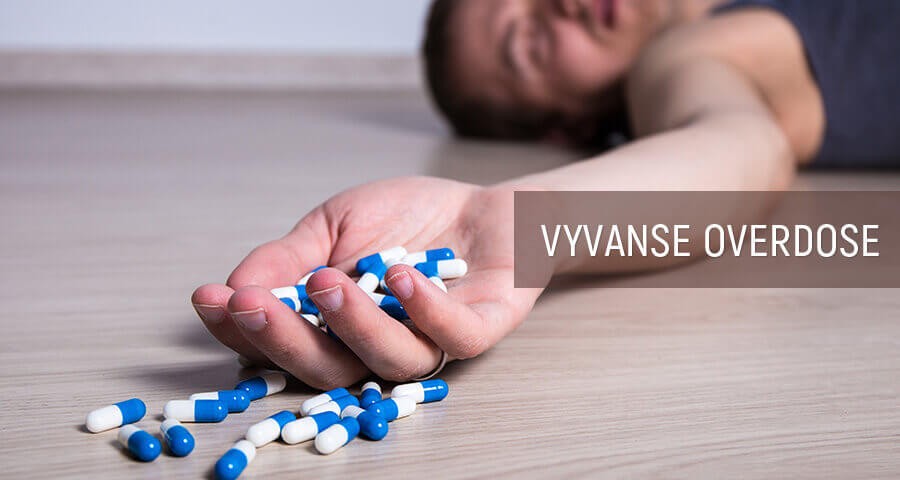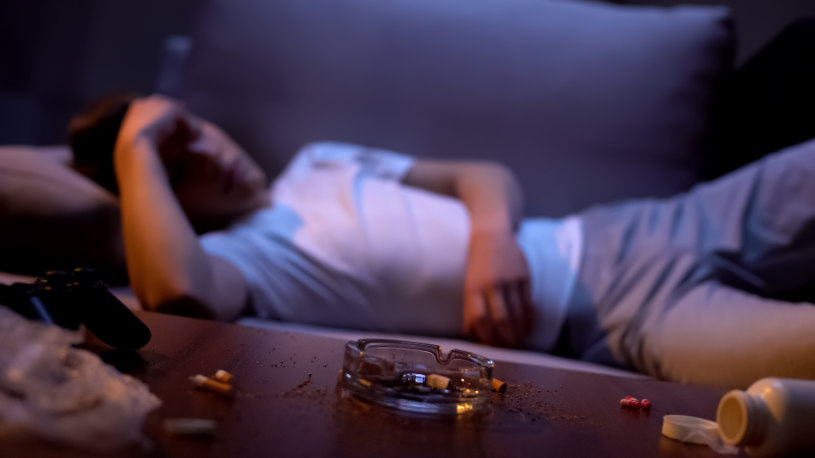Vyvanse Overdose And The Dangers Of Snorting Vyvanse

Vyvanse, the most common brand name of Lisdexamfetamine, is a medication used for the treatment of Attention-Deficit Hyperactivity Disorder (ADHD) and Binge Eating Disorder (BED). The prevalence of these two conditions in the United States is quite common. It is estimated that approximately 4–9% of children and 4% of adults are diagnosed with ADHD and approximately 1.2% of adults are diagnosed with BED. As a consequence, prescriptions for medications used for these conditions, including stimulants/amphetamines such as Vyvanse, are on the rise.
Table Of Contents:
It is estimated that around 2.7 million prescriptions for children and presumably even more for adults are written annually just for ADHD. Unfortunately, the same statistics are not available for BED. Regardless, the wider availability of these medications, including Lisdexamfetamine, makes the probability of recreational use such as snorting Vyvanse, substance abuse or addiction, and overdose on Vyvanse is very high.
This article tackles the topics of Vyvanse overdose and its consequences as well as recreational abuse of Vyvanse through snorting or more correctly termed nasal insufflation
Is It Possible To Overdose On Vyvanse?
Among amphetamines and CNS-stimulants, Lisdexamfetamine is thought to be the least prone to abuse and the development of substance addiction. This is the result of its chemically-phased release that allows for once-daily dosing that theoretically deters abuse. Regardless of this fact, amphetamine use and abuse for recreational purposes still occurs. And the largest concern for amphetamine abuse for recreational use is Vyvanse overdose. Overdose or acute intoxication refers to the consumption of drugs or other substances in quantities greater than are recommended which results in the damage of the user’s health. Poison Control in the United States counts about 17,000 cases of toxic-level exposure to ADHD medication every year, but the CDC counts this rate as being much lower, at under 200 instances a year. No matter how prevalent it is for people to consume toxic levels of ADHD medication, the fact remains it does occur. However it is worth mentioning that there have been no cases of Lisdexamfetamine overdose reported, but this is not to say that this medication is incapable of producing an overdose.
Dangers Of Vyvanse Overdose
During an overdose on amphetamines, this includes Vyvanse overdose, there is an excess of extracellular dopamine, norepinephrine, and serotonin which causes cellular toxicity. This toxicity manifests itself primarily with neurological and cardiovascular effects but secondary complications involving renal, musculoskeletal, pulmonary, and gastrointestinal systems may also occur.
Lastly, the greatest consequence that can be associated with overdose on Vyvanse is death. While significant morbidity is common with amphetamine and/or Vyvanse overdose, fatalities are less common than with other drugs of abuse and unfortunately in survivors of drug intoxication devastating long-term health effects can be seen.
While it is common for those abusing the drug to tell themselves they know how to avoid intoxication, the truth is that how much Vyvanse needed to overdose can change day to day based on a variety of factors, including if the medication is actually counterfeit. Anyone who is using the drug incorrectly or without medical supervision is at risk

Signs And Symptoms Of Vyvanse Overdose
Overdose on Vyvanse presents with the same medical signs and symptoms as an amphetamine overdose. As previously mentioned, intoxication with amphetamines presents primarily with medical symptoms and signs related to neurological and cardiovascular systems but secondary symptoms and signs from renal, musculoskeletal, pulmonary, and gastrointestinal systems can also be encountered.
Below Are Offered the Most Common Symptoms and Signs Associated With an Overdose on Vyvanse:
- Neurological Manifestations: These may include mydriasis, tremor, agitation, hostility, combative behavior, suicidal and homicidal ideations, hallucinations, delirium, confusion, paranoia, anxiety, hyperreflexia, movement disorders, and seizures. In severe cases seizures may progress to status epilepticus or be followed by a postictal/post-seizure coma.
- Cardiovascular Manifestations: The most prominent cardiovascular manifestations include angina/chest pain, tachycardia, hypertension, and dysrhythmias. Uncommonly aortic dissection, vasospasm, cerebral vasculitis with subsequent intracerebral hemorrhage/stroke and myocardial infarction may also occur.
- Autonomic Manifestations: Hyperthermia refers to the body temperature becoming too high. As it overheats, severe sweating begins. If left untreated hyperhidrosis will lead to dehydration and an excessively high body temperature will lead to neuronal damage.
- Musculoskeletal and Renal Manifestations: Seizures and high body temperature will lead to damage of skeletal muscle cells, a phenomenon called Rhabdomyolysis. Damaged muscle cells produce myoglobin, a storage compound for oxygen in muscle cells. Myoglobin in high quantities cannot be filtered by the kidneys and causes damage to them. This can lead to renal failure and acidosis.
- Gastrointestinal Manifestations: These include nausea, vomiting, diarrhea and abdominal cramps
- Respiratory Manifestations: As the oxygen levels in the blood drop, the body may start rapid breathing to try to combat the carbon dioxide in the blood, causing the user to hyperventilate. Hyperventilation can produce respiratory alkalosis.
Death from intoxication with amphetamines and other drugs keeps on rising, and it is estimated that these death rates will continue to rise. To prevent death, early recognition of the signs and symptoms of this phenomenon is crucial. After recognition, contact and provision of essential information regarding the intoxication to an Emergency Medical Health Center or a Poison Control Center will enable the patient to receive immediate medical treatment to help their recovery.
Snorting Vyvanse
Intranasal administration of oral drugs through snorting or more correctly termed nasal insufflation, is becoming more prevalent. This form of drug administration is quite frequently employed by substance abusers, and this comes as no surprise as intranasal administration is associated with enhanced abuse and addiction potential.
With regard to snorting Vyvanse, there is unfortunately a lack of statistical information relating specifically to the prevalence and side effects of intranasal administration of Lisdexamfetamine. However, a few research studies have documented instances of nonmedical use of prescription ADHD stimulants through nasal insufflation and have described the growing prevalence of crushing and snorting these medications.
Snorting this medication, as well as other ways of abuse, poses not only danger to the user’s health, it is also illegal.
Can You Snort Vyvanse?
The answer to the question “Can you snort Vyvanse?” or “Is Vyvanse Snortable?” is technically yes, it is physically possible to administer Lisdexamfetamine intranasally. The pills of this prescription medication can be crushed into a powdered form and snorted up into the nose. However, it is important to remember that this method of administration will not deliver desirable effects, nor is it a safe method of use.
Why People Start Snorting Vyvanse
Each user will have their own reasons for trying. Some believe that snorting is safer than other modes of consumption – which is false. However, the primary reason people choose to snort this medication and other drugs is because they believe that snorting Vyvanse will allow the effects of the drug to come on sooner and be felt more powerfully. With some drugs, snorting does increase effects. The nasal passages instantly absorb the medication and send it into the bloodstream, bringing on the effects of the drug rapidly.
However, with Vyvanse snorting, while the nasal passages can absorb the medication and send it directly into the central circulation, no stimulant effects will be experienced or observed as Lisdexamfetamine is a prodrug that is encased in a layer of lysine that requires gastric enzymes to activate it to the active drug Dextroamphetamine. Theoretically, some of the snorted Lisdexamfetamine could make it through the sinuses and down the throat, then into the stomach, allowing the acids there to strip the lysine and activate the medication. However, even if this were to occur, the stimulant effects would be negligible and much less than if the medicine was taken by simply swallowing the capsule or chewing a tablet.
Side Effects And Dangers Associated With Snorting Vyvanse
If a person chooses to snort Lisdexamfetamine in powder form rather than orally ingesting it either by swallowing or chewing, this could indicate one of two things. Either the user has problems with amphetamine addiction or the user is attempting to use the drug recreationally. Drug abuse comes with significant personal risks. Frequently, drug use consumes the addict, leading to a loss of friends and alienation of family. The user snorting Vyvanse often spends significant time and money on accessing their drug, causing them to struggle to support themselves or their family and placing a heavy financial burden on them.

As mentioned before, administering Lisdexamfetamine intranasally will produce little to no side effects, whether physiological or psychological, that are related to the stimulant properties of the drug as intranasally administered Lisdexamfetamine is inactive. However, if a person were to insufflate or snort crushed Vyvanse or any other medication certain nasal cavity, sinus as well as possible respiratory complications could develop. These complications are more likely to be associated with chronic intranasal administration of powdered drugs and include the following symptoms and signs :
- Orofacial-nasal pain
- Sinonasal congestion
- Rhinorrhea and Sinus drainage
- Dysphagia/Difficulty swallowing
- Hoarseness of voice and Difficulty speaking
- Epistaxis/Nosebleed
- Otalgia/Earache
- Nasal, Oral, and/or Pharyngeal mucosal necrosis and crusting
- Nasal septal perforation
- Oropharyngeal ulceration
- Palatal perforation
- Fevers/chills due to infections of the nose, throat, and sinuses
- Facial swelling
Insufflation of Powdered Drugs Could Also Lead to Respiratory Complications Such As:
- Asthma, manifesting with bronchospasm, wheezing, and dyspnea/difficulty breathing
- Eosinophilic Lung Disease due to powder deposition in lungs can also rarely occur. This disease is manifested with fever, decreased oxygen concentration in blood, hemoptysis/coughing up blood, respiratory failure, and accumulation of fluid-like excretions within the lungs.
- Respiratory infections such as pneumonia can also occur more frequently.
Lastly, while physical signs and symptoms are significant, social and familial consequences of abusing Vyvanse are significant. These Produce More Psychological Side Effects and Could Include:
- Depression
- Anxiety
- Struggles with anger management
- Panic attacks
- Suicidal ideations
Anyone who is snorting Lisdexamfetamine should stop to consider the potential consequences of their actions and the long-term effects of Vyvanse they might have to live with. Doing so could be lifesaving. None of the potential side effects of snortable Vyvanse are minor. All of them will have a negative impact on the health and the quality of life of the user, and some of them have the potential to be deadly. If a user cannot stop snorting, there is a need to undergo an addiction treatment and recovery program. Anyone who is consuming the drug should only do so as directed by a doctor, never snorting the drug or taking more than the recommended dose. Furthermore, no one should buy Vyvanse online and especially not on the street.
Recreational use through intranasal administration of any drug is equivalent to abuse and is legally prosecuted.
Risk Factors And At-Risk Groups
Not everyone who takes the medication is at risk of a Lisdexamfetamine overdose. Those who are legally prescribed the medication, and take it exactly as directed by their doctor, and are honest and forthcoming with information regarding all other substances and prescription medications they are using are unlikely to reach the Vyvanse overdose amount.
With Regard to Those Who Are At-Risk for Abusing Lisdexamfetamine or From Overdosing on This Medication Could Include:
- Young users who may experiment with this medication for recreational purposes.
- Those users who engage in polysubstance abuse, and combine the use of this medication with other drugs and substances such as alcohol. Combining this drug with alcohol and other drugs, greatly reduces the dose needed to trigger life-threatening responses in the body and also increases the risk of dangerous drug interaction. As such drinking while taking Vyvanse is never recommended and should be avoided.
- The elderly and those with other mitigating health conditions and comorbidities could also have a higher risk of overdose since their bodies are less likely to process the medication well, and the drug may stay in their system longer.
Furthermore, anyone who develops tolerance to Lisdexamfetamine is also more likely to overdose. This is because they may feel the need to increase their dose to achieve the same effects they previously experienced and they may experience the Vyvanse withdrawal symptoms more forcefully, which is a sign to ask the doctor for the possible alternatives to the medicine.

Preventing Vyvanse Overdose
Preventing a Vyvanse overdose comes down to taking the medication correctly and only under the supervision of a doctor. This means not taking the medication without a legal prescription, only taking the doses prescribed at the recommended times, and taking care never to consume too much Vyvanse. It is also critical that the patient is honest and forthcoming with their doctor with information about any other medications they are taking or substances they are using. Many overdoses are caused by polysubstance abuse, allowing for fatal reactions at lower doses. When the doctor inquires about what else the patient uses, they must be honest. If symptoms of Vyvanse abuse are noticed, loved ones should encourage the user to seek treatment from a rehabilitation and recovery center.
Recovery From Vyvanse Overdose
The immediate treatment for Lisdexamfetamine overdose should be offered in the emergency room setting. There, the medical staff will work to clear the toxins from the body, combat the negative symptoms, and stabilize the patient. This can be done through the use of activated charcoal, saline IVs, and medications. The recovery process from an overdose is complicated. If the user is addicted to Lisdexamfetamine dimesylate, they will begin experiencing withdrawal symptoms at the same time they are fighting back from the event.
Because the symptoms, including Vyvanse sexual side-effects, muscle twitches, and delayed motor response, are unpleasant, they increase the likelihood that the person may relapse, making the chances of Vyvanse overdose even greater. It is imperative that the user seek help during the withdrawal phase. Anyone who has experienced an overdose should seek rehabilitation treatment. There, they can develop the skills and strategies needed to get and remain clean. A better life is possible with the right help.
Hope Without Commitment
Find the best treatment options. Call our free and confidential helpline
Most private insurances accepted
Page Sources
- Martin D, Le JK. Amphetamine. [Updated 2020 Aug 28]. In: StatPearls [Internet]. Treasure Island (FL): StatPearls Publishing; 2021 Jan-. Available from: https://www.ncbi.nlm.nih.gov/books/NBK556103/
- Centers for Disease Control and Prevention (CDC). Increasing prevalence of parent-reported attention-deficit/hyperactivity disorder among children: United States, 2003 and 2007. MMWR Morb Mortal Wkly Rep. 2010;59(44):1439–43
- Krishnan, S., & Montcrief, S. (2007). Toxicity profile of lisdexamfetamine dimesylate in three independent rat toxicology studies. Basic & clinical pharmacology & toxicology, 101(4), 231–240. https://doi.org/10.1111/j.1742-7843.2007.00093.x
- Spiller, H.A., Hays, H.L. & Aleguas, A. Overdose of Drugs for Attention-Deficit Hyperactivity Disorder: Clinical Presentation, Mechanisms of Toxicity, and Management. CNS Drugs 27, 531–543 (2013). https://doi.org/10.1007/s40263-013-0084-8
- Vasan S, Olango GJ. Amphetamine Toxicity. [Updated 2021 Jul 10]. In: StatPearls [Internet]. Treasure Island (FL): StatPearls Publishing; 2021 Jan-. Available from: https://www.ncbi.nlm.nih.gov/books/NBK470276/
- Visser, S. N., Lesesne, C. A., & Perou, R. (2007). National estimates and factors associated with medication treatment for childhood attention-deficit/hyperactivity disorder. Pediatrics, 119 Suppl 1, S99–S106. https://doi.org/10.1542/peds.2006-2089O

 Authored by
Authored by  Reviewed by
Reviewed by 



